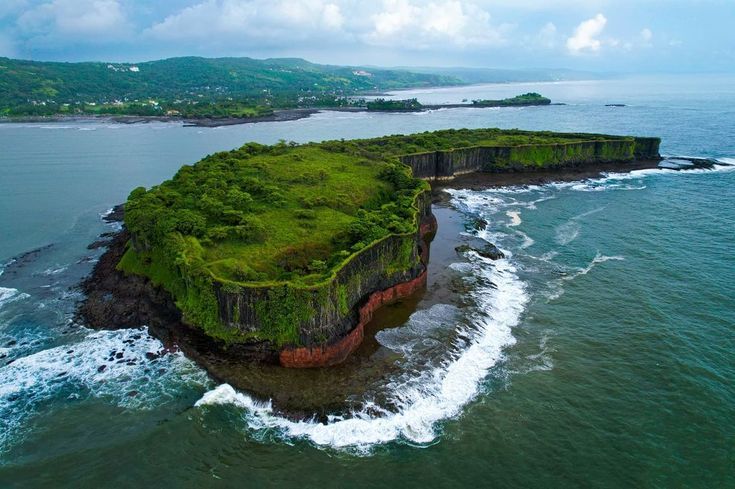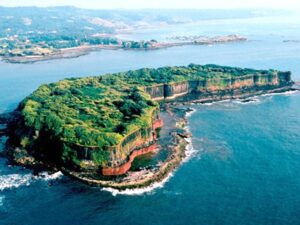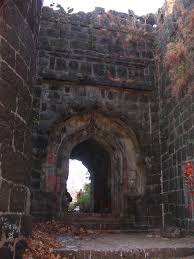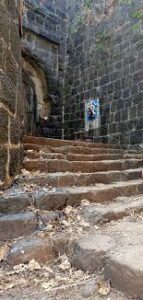
Table of Contents
Suvarnadurg Fort

Suvarnadurg Fort, a majestic sea fortress off the Konkan coast of Maharashtra, stands as a testament to the strategic brilliance of the Maratha Empire. Built during the Bahmani Sultanate and later fortified by Chhatrapati Shivaji Maharaj, this formidable structure played a crucial role in Maratha naval dominance.
Surrounded by the Arabian Sea, the fort’s thick walls and well-planned architecture made it nearly impenetrable. It served as a vital defense post, safeguarding trade routes and resisting enemy invasions. The fort complex includes bastions, hidden escape routes, and an ancient dry dock used for repairing warships.
Today, Suvarnadurg Fort is a fascinating historical site, attracting adventurers and history enthusiasts alike. Accessible via boat from Harnai, it offers stunning views of the coastline and a glimpse into Maharashtra’s glorious past. Exploring this Maratha naval wonder is a journey through time, celebrating the legacy of one of India’s greatest warriors.
Historical Significance
Suvarnadurg Fort, a maritime stronghold along the Konkan coastline, has a rich and layered history that dates back to the Bahmani Sultanate. Over centuries, it became a critical naval and military base for several ruling dynasties, eventually reaching its peak of strategic importance under the Maratha Empire.
Early History and Construction
Suvarnadurg Fort has a long and intriguing history, evolving from a land-based fortification to a strategic sea fort. It was originally built as a coastal defense structure during the rule of the Bahmani Sultanate in the 14th or 15th century. During this period, its primary function was to act as a watchtower against foreign invasions, particularly from Arab traders and Portuguese explorers who had begun to establish their dominance along the Indian coastline.

Sultanate Rule and Early Modifications
After the decline of the Bahmani Sultanate, the fort came under the control of the Deccan Sultanates, particularly the Adil Shahi dynasty of Bijapur. The Adil Shahis made minor improvements to the fort, using it as a military outpost to oversee the surrounding sea routes. However, during this time, Suvarnadurgwas still a relatively small and less fortified structure, primarily serving as a defensive lookout post rather than a full-fledged naval base.
Shivaji Maharaj’s Vision and Expansion
The true transformation of Suvarnadurg Fort occurred in the 17th century, when Chhatrapati Shivaji Maharaj recognized its strategic significance. As part of his larger naval expansion policy, he embarked on a mission to fortify key coastal locations along the Konkan coastline. His primary objectives were to:
- Counter foreign naval threats from the Portuguese, British, Dutch, and Siddis.
- Establish a stronghold to control maritime trade routes.
- Strengthen the Maratha Navy to protect coastal territories.
Fortification and Naval Strengthening
Under Shivaji Maharaj’s rule, Suvarnadurg Fort underwent major renovations, transforming it into a powerful naval fort. The modifications included:
- Massive stone walls and high ramparts to withstand enemy artillery attacks.
- Strategic bastions and watchtowers to monitor enemy ship movements.
- A fortified entrance gate designed to prevent easy access for attackers.
- A hidden underground escape route, believed to have connected the fort to Kanakdurg Fort on the mainland.
- Deep wells and water storage systems to ensure self-sufficiency during long sieges.
- A dry dock for ship repairs, showcasing Shivaji Maharaj’s advanced naval planning.
By reinforcing Suvarnadurg, Shivaji Maharaj effectively transformed it into a maritime fortress capable of launching naval expeditions and protecting Maratha interests in the Arabian Sea. The fort became a crucial part of Shivaji Maharaj’s coastal defense strategy, along with other sea forts like Sindhudurg, Vijaydurg, and Khanderi.
Maratha Naval Supremacy Begins
After the fortification of Suvarnadurg, the Maratha Navy grew significantly under Shivaji Maharaj’s leadership. The fort served as a base for patrolling enemy waters, attacking invading fleets, and securing maritime trade routes. It played a crucial role in ensuring that the Konkan coast remained under Maratha control, free from European colonial influence.
Following Shivaji Maharaj’s passing, Suvarnadurg Fort continued to be a naval stronghold under the leadership of Kanhoji Angre, who would later make it the headquarters of the Maratha Navy. This transformation marked the beginning of an era where the Marathas emerged as a dominant naval force in the Indian Ocean.
Today, the ruins of Suvarnadurg Fort still reflect its glorious past, standing as a testament to Shivaji Maharaj’s foresight and military genius.

Shivaji Maharaj’s Naval Expansion
- Shivaji Maharaj’s naval policy focused on safeguarding the Konkan coastline from foreign invaders such as the Portuguese, British, and Siddis.
- He fortified Suvarnadurg Fort by building high stone walls, watchtowers, and bastions designed to repel enemy attacks.
- The fort served as a maritime surveillance center, allowing the Marathas to monitor enemy movements along the western coast of India.
- Suvarnadurg Fort became a key trade route checkpoint, ensuring that maritime commerce was controlled and protected from foreign interference.
Kanhoji Angre – The Legendary Naval Commander
Following Shivaji Maharaj’s reign, Kanhoji Angre, one of the greatest Maratha naval commanders, took charge of Suvarnadurg Fort and elevated it to unprecedented prominence. Born in 1669, Angre played a pivotal role in expanding and strengthening the Maratha Navy, ensuring dominance over the Konkan coastline and the Arabian Sea. His naval prowess made him a formidable adversary to European colonial powers, earning him the title of “Samudratla Shivaji” (Shivaji of the Sea).
Suvarnadurg Fort as a Naval Base
Under Kanhoji Angre’s leadership, Suvarnadurg Fort became the headquarters of the Maratha Navy, serving as a strategic stronghold for naval operations. The fort’s location allowed him to control key trade routes, defend Maratha coastal territories, and launch attacks against foreign invaders. Suvarnadurg, along with other forts like Sindhudurg, Vijaydurg, and Khanderi, formed an impenetrable naval defense network.
- Trade and Revenue Control: Angre imposed taxes on foreign ships passing through Maratha-controlled waters, generating significant revenue for the empire.
- Naval Patrols and Defense: The fort housed a well-trained naval force that patrolled the Arabian Sea, ensuring security from pirate attacks and European incursions.
- Advanced Communication System: Angre implemented an efficient signaling system using flags and fire beacons to relay messages between Suvarnadurg Fort and other sea forts, ensuring coordinated defense operations.

Battles Against European Powers
Kanhoji Angre’s naval campaigns struck fear into the British, Portuguese, Dutch, and Siddis, as he repeatedly outmaneuvered and defeated their fleets. He successfully resisted multiple attacks and upheld Maratha supremacy in the Arabian Sea for nearly four decades.
- Victory Against the British East India Company: The British attempted to subdue Angre’s forces several times but failed due to his superior naval tactics and extensive knowledge of coastal waters.
- Conflict with the Portuguese: The Portuguese sought to expand their influence along the Konkan coast, but Angre’s unrelenting attacks on their ships and forts forced them to retreat.
- Defeating the Dutch: Angre’s navy captured Dutch ships and outposts, further solidifying Maratha control over regional trade routes.
- Resistance Against the Siddis: The Siddis, backed by the Mughal Empire, frequently engaged in maritime conflicts with Angre. However, his strategic use of guerilla warfare at sea ensured continued Maratha dominance.
Innovations in Naval Warfare
Kanhoji Angre was a visionary naval strategist who introduced several advancements in maritime warfare, making the Maratha Navy one of the strongest in India.
- Shipbuilding Expertise: He pioneered indigenous shipbuilding techniques, constructing swift and maneuverable warships that could outpace European vessels.
- Naval Dockyard: Angre established a dry dock within Suvarnadurg, allowing for regular maintenance and repair of warships, ensuring a well-equipped fleet.
- Defensive Fortifications: He reinforced Suvarnadurg’s walls, stationed powerful cannons, and built additional watchtowers, making the fort almost impenetrable.
- Use of Fast Attack Ships: Unlike the heavy European ships, Angre’s fleet consisted of smaller, faster boats, allowing quick ambushes and tactical retreats.
Unconquered by the British for Years
Despite numerous attempts, the British East India Company and its allies failed to capture Suvarnadurg Fort for decades due to Angre’s unmatched naval expertise. His knowledge of coastal geography, mastery of guerrilla warfare at sea, and ability to launch surprise attacks made him an unbeatable naval commander.
Even after his passing in 1729, the legacy of Kanhoji Angre endured, and his successors continued to defend Suvarnadurg Fort until 1755, when the British, in alliance with the Peshwas, finally captured the fort. However, by this time, Angre’s contributions had already cemented the Marathas as a dominant naval power.

Kanhoji Angre’s Legacy
Kanhoji Angre’s impact on Indian maritime history remains unparalleled. His innovative strategies, fearless leadership, and unwavering dedication to protecting Maratha interests in the Arabian Sea earned him a place among India’s greatest warriors. Today, Suvarnadurg Fort stands as a symbol of his naval brilliance, reminding visitors of the era when the Maratha Navy ruled the western waters.
Key Historical Events at Suvarnadurg Fort
- 1670s – Chhatrapati Shivaji Maharaj fortified Suvarnadurg Fort, making it a strategic naval stronghold.
- 1698 – Kanhoji Angre took control and established Suvarnadurg Fort as the Maratha Naval Headquarters.
- 1713 – Angre decisively defeated the British East India Company’s fleet, preventing their expansion along the Konkan coast.
- 1729 – After Kanhoji Angre’s passing, his successors continued to rule the fort, keeping it under Maratha control.
- 1755 – The British, in alliance with the Peshwas, finally managed to capture Suvarnadurg Fort, marking a significant shift in power along the coast.
Maratha Naval Supremacy and Legacy
Suvarnadurg Fort was not just a military fort; it was a symbol of Maratha naval supremacy and maritime resilience.
- It housed a shipbuilding dock, which helped maintain and expand the Maratha naval fleet.
- The fort’s defensive bastions, hidden escape tunnels, and deep wells ensured self-sufficiency and resistance against long sieges.
- It played a pivotal role in shaping India’s coastal defense strategies, inspiring future generations in naval warfare.
Even after the British takeover, Suvarnadurg Fort remained a testament to Maratha maritime strength and the vision of Shivaji Maharaj and Kanhoji Angre. Today, it stands as a historical relic, echoing the glorious past of India’s maritime history.

Key Historical Events:
- 1670s – Chhatrapati Shivaji Maharaj fortified the fort, enhancing its defenses and integrating it into his larger naval strategy.
- 1698 – Kanhoji Angre took control of Suvarnadurg Fort and developed it into an invincible naval base.
- 1713 – The fort played a critical role in Maratha naval battles, as Kanhoji Angre successfully defeated the British East India Company in multiple encounters.
- 1729 – After Kanhoji Angre’s death, his sons continued to rule the fort, maintaining Maratha supremacy at sea.
- 1755 – The British, in alliance with the Peshwas of Pune, launched a powerful naval attack and captured Suvarnadurg Fort, marking a significant shift in power along the Konkan coast.
During its peak, Suvarnadurg Fort was an impenetrable fortress, with massive stone walls, strategic bastions, and hidden escape routes. It housed an ancient shipbuilding dock, showcasing the advanced naval engineering of the Maratha era. This dock played a crucial role in maintaining and expanding the Maratha fleet, allowing them to build and repair warships, which further strengthened their control over the Arabian Sea.
The fort also contained military barracks, storage rooms for ammunition, freshwater reservoirs, and a secret network of tunnels, designed to provide escape routes during enemy sieges.
The Marathas’ control over Suvarnadurg Fort instilled fear among colonial powers, particularly the British and Portuguese, who saw it as a major obstacle to their expansion. Even after its capture by the British in the 18th century, the fort remained a testament to the Maratha Empire’s maritime supremacy and resistance against foreign invaders.
Architectural Marvel
Suvarnadurg Fort exhibits classic Maratha military architecture, designed to withstand enemy attacks and the relentless sea waves. Some of its notable features include:
- Massive Fortifications: The fort is surrounded by thick stone walls and strategically placed bastions, offering defense from all directions. The fortifications were meticulously designed to absorb cannon fire and withstand natural erosion from the sea.
- Hidden Escape Routes: Secret underground pathways helped warriors escape during attacks. These tunnels, though now lost or inaccessible, were a crucial part of the fort’s defense strategy.
- Ancient Dry Dock: The fort had its own dock for ship repairs, showcasing the advanced naval engineering of the Maratha era. This dock, once used to maintain and construct warships, highlights the foresight of the Maratha rulers in maritime warfare.
- Watchtowers & Cannons: Elevated watchtowers provided panoramic views of approaching enemy ships, while old cannons hint at the fort’s military past. Some of these cannons, although rusted, remain scattered across the fort premises, reminding visitors of its war-driven history.
- Grand Entrance Gate: The main entrance, adorned with traditional Maratha motifs, was built to be both aesthetically impressive and highly defensive, restricting easy enemy access.
- Multiple Water Reservoirs: The fort had several wells and reservoirs that ensured a steady supply of drinking water. These water tanks were vital for sustaining the Maratha soldiers stationed at the fort.
- Stone-Carved Steps and Pathways: The inner pathways of the fort are carved out of rock, leading to different sections, including military quarters, storage areas, and bastions.
- Durga Devi Temple: Within the fort premises lies a temple dedicated to Goddess Durga, believed to be the guardian deity of the fort. Pilgrims and history enthusiasts still visit this temple to offer prayers and appreciate its ancient architecture.
- Defensive Traps and Moats: The fort also had a sophisticated system of traps, false doors, and moats designed to confuse and mislead enemies attempting to breach its defenses.
Despite centuries of exposure to natural elements, the fort remains a stunning relic of Maratha naval prowess. Its strategic design, blending natural landscape with military architecture, makes it one of the most significant coastal forts in India.

Accessibility & How to Reach
Suvarnadurg Fort is located near Harnai village in Ratnagiri district. The fort is surrounded by water and can only be accessed by boat. Travelers can reach the fort as follows:
- By Road: The nearest city is Dapoli, around 17 km away. Regular buses, private taxis, and rental vehicles connect Dapoli to Harnai. The roads leading to Harnai offer scenic views of the lush Konkan countryside, making for a pleasant journey.
- By Boat: Boats from Harnai port ferry tourists to the fort. The ride offers stunning panoramic views of the Arabian Sea and is an exciting experience for visitors. It is advisable to check boat availability and weather conditions before planning the trip.
- By Rail: The nearest railway station is Khed, approximately 40 km from Harnai. From Khed, travelers can hire a taxi or take a local bus to reach Harnai. The journey through the picturesque Konkan landscape adds to the travel experience.
- By Air: The closest airport is Ratnagiri Airport, about 130 km away. From Ratnagiri, visitors can opt for a private cab or bus to reach Dapoli and then travel further to Harnai.
- By Private Transport: Travelers from Mumbai (215 km) and Pune (200 km) can drive to Harnai via the Mumbai-Goa Highway (NH66). The scenic route includes winding roads, lush green hills, and coastal views, making the drive an enjoyable part of the journey.
Local Transport: Once in Harnai, visitors can hire auto-rickshaws, taxis, or rental bikes for local travel. Exploring nearby attractions
Best Time to Visit
The best time to visit Suvarnadurg Fort is during the winter months (October to March) when the weather is pleasant and favorable for sightseeing. Since the fort is accessible only by boat, it is important to consider sea conditions while planning your visit. Each season offers a different experience, so choosing the right time can enhance your overall trip.
Winter (October to March) – The Ideal Time to Visit
Weather: Winter months provide the most comfortable climate, with temperatures ranging between 15°C to 28°C. The cool breeze, clear skies, and calm sea conditions make it the best time for exploration.
Why Visit in Winter?
- Ideal for sightseeing, as the weather is pleasant and the heat is minimal.
- Safe and smooth boat rides from Harnai Port, offering stunning views of the fort from the sea.
- Perfect for photography, as the bright blue sky and sea contrast beautifully with the fort’s rugged stone walls.
- Great for history enthusiasts who wish to explore the fort without exhaustion from heat or humidity.
Monsoon (June to September) – Scenic but Risky
Weather: The region experiences heavy rainfall, leading to lush greenery, mist-covered landscapes, and an overall picturesque ambiance. However, sea conditions can be dangerous.
Things to Consider:
- Boat services to the fort may be suspended due to high tides and rough waters, making it difficult or even impossible to reach the fort.
- Strong winds and continuous rainfall can make the fort’s stone pathways slippery, increasing the risk of accidents.
- While the monsoon enhances the fort’s beauty, it is not the safest time for tourists.
- However, if you enjoy monsoon landscapes and do not plan to enter the fort, visiting Harnai Beach or viewing the fort from a distance could still be an enjoyable experience.
Summer (April to May) – Hot and Challenging
Weather: Temperatures can soar up to 35°C or more, making daytime travel and exploration uncomfortable due to intense heat and humidity.
Things to Consider:
- The fort lacks adequate shade, making it difficult to explore for long hours under the scorching sun.
- If visiting during summer, plan your trip early in the morning (before 10 AM) or in the late afternoon (after 4 PM) to avoid extreme heat.
- Carry plenty of water to stay hydrated, wear light clothing, and apply sunscreen to protect against sunburn.
- Boat rides may still be available, but sea conditions can become unpredictable during peak summer months.
Best Time to Plan Your Visit
For the best experience, visiting Suvarnadurg Fort during early winter (November to December) or late monsoon (September) allows travelers to enjoy pleasant weather conditions while witnessing the breathtaking beauty of the Arabian Sea. Avoid peak monsoon season to ensure safe travel and an uninterrupted exploration of the fort’s rich history and architecture.

Things to Do at Suvarnadurg Fort
- Explore the Ruins: Walk through the fort’s ancient pathways, bastions, and gateways, reliving its glorious past.
- Photography: Capture breathtaking views of the Konkan coastline and the Arabian Sea.
- Boating Adventure: Enjoy a scenic boat ride from Harnai, offering a mesmerizing view of the fort from the sea.
- Visit Nearby Attractions: Explore Harnai Beach, Anjarle Ganpati Temple, and Murud Beach, located close to the fort.
- Witness the Architectural Grandeur: Admire the massive stone walls, strategic watchtowers, and the ancient dockyard, which played a vital role in the Maratha naval force.
- Experience the Thrill of Trekking: The fort’s rugged terrain and steep stone steps provide an exciting trekking experience for adventure enthusiasts.
- Discover Hidden Passages: Search for the mysterious tunnels and escape routes that once allowed warriors to outmaneuver enemies.
- Enjoy Birdwatching: The fort’s isolated location and rocky shores attract a variety of seabirds, making it an ideal spot for birdwatching.
- Sunset Viewing: The fort offers stunning sunset views over the Arabian Sea, creating a picture-perfect moment for visitors.
- Learn About Maratha Naval History: Immerse yourself in the stories of Shivaji Maharaj, Kanhoji Angre, and the fearless Maratha navy, which ruled the western waters of India.
- Relish Local Cuisine: After exploring the fort, indulge in Konkan delicacies at Harnai village, including fresh seafood, Malvani curries, and traditional Maharashtrian sweets.
- Explore the Fishing Harbor: Visit the bustling fish market of Harnai, one of the largest on the Konkan coast, where fishermen bring in fresh catches every morning.
- Scuba Diving & Water Sports (Nearby): For adventure seekers, nearby coastal spots offer scuba diving, snorkeling, and water sports, providing an opportunity to explore marine life.
Interesting Facts
- The fort was originally a land fort, but Shivaji Maharaj expanded it into a sea fortress.
- Kanhoji Angre, one of India’s greatest naval commanders, controlled the fort and fought against the British and Portuguese.
- The fort was connected to Kanakdurg Fort, a smaller fort on the mainland, via a hidden undersea tunnel, which is now lost to time.
- Despite British attacks, the Marathas successfully defended Suvarnadurg Fort for decades.
- The fort was self-sufficient, with wells and water reservoirs ensuring a steady supply of fresh water for the garrison.
- Suvarnadurg Fort was a part of the Maratha Navy’s formidable defense network, which also included Sindhudurg and Vijaydurg forts.
- The fort once housed a small settlement of soldiers and their families, demonstrating its strategic importance beyond just military use.
- The British captured Suvarnadurg Fort in 1755 after a prolonged struggle, marking the decline of Maratha naval supremacy.
- The fort still contains ancient inscriptions, believed to be left by Maratha rulers, providing insights into its glorious past.
- Massive stone steps lead to the fort’s entrance, built in a way to slow down enemy advances in case of an attack.
- Suvarnadurg’s walls were designed to withstand high tidal waves, showcasing the Marathas’ understanding of maritime defense engineering.
- The fort’s name, ‘Suvarnadurg Fort,’ suggests wealth and prosperity, indicating its importance as a naval and trade hub.
Conclusion
Suvarnadurg Fort is not just a historical monument; it is a symbol of the Maratha Empire’s naval brilliance and strategic vision. Visiting this fort offers a glimpse into India’s rich maritime history and the legacy of Shivaji Maharaj and Kanhoji Angre. Whether you are a history buff, a traveler, or an adventure seeker, Suvarnadurg Fort is a must-visit destination that continues to stand tall as a proud relic of India’s glorious past.
Beyond its historical significance, the fort also represents the resilience, courage, and tactical expertise of the Maratha navy. Exploring Suvarnadurg Fort allows visitors to appreciate the meticulous planning that went into securing the Konkan coastline. The fort’s scenic surroundings, combined with its architectural grandeur, make it a perfect destination for those who love adventure, history, and photography.
A trip to Suvarnadurg Fort is more than just a visit to a historic site; it is a journey through time, offering a deep connection to India’s maritime heritage. Standing atop the fort’s sturdy walls, one can almost hear the echoes of the past—of warriors defending their land, of warships setting sail, and of a legacy that continues to inspire generations.
Suvarnadurg Fort Map
Follow More Article
